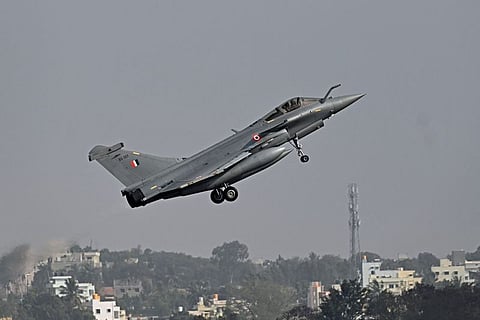Explained: Rafale fighter jets, India’s new defence powerhouse
From specs to strategic impact — what makes Rafale jet game-changer for India’s military

Dubai: The Rafale fighter jet is a key addition to India’s armed forces, part of a broader effort to modernise its military, reduce reliance on Russian-origin equipment, and expand domestic weapons production to support deployments along the borders with Pakistan and China.
The Rafale has made headlines after the Indian Press Information Bureau (PIB) debunked several false claims circulating in Pakistani media and on social platforms following Indian Army airstrikes in Pakistan and Pakistan-administered Kashmir on Wednesday.
In response to Operation Sindoor, which targeted 9 camps in Pakistan-run Kashmir and Pakistan, various accounts falsely claimed retaliatory strikes on 15 Indian locations, including attacks on Srinagar Airbase and destruction of Indian Army facilities and fighter jets.
Before the latest escalation, the Indian Air Force operated 36 Rafale jets, while the Navy primarily relied on Russian-made MiG-29 aircraft. In late April, India signed a new deal with France’s Dassault Aviation to purchase 26 additional Rafale jets for the Navy, worth ₹630 billion ($7.4 billion).
According to Indian officials, delivery will be completed by 2030, with crew training to take place in both France and India. The deal, approved by India’s security cabinet chaired by Prime Minister Narendra Modi, is expected to generate thousands of jobs and create revenue for a wide network of domestic businesses.
Rafale fighter jets: Specifications, cost and combat power
The Dassault Rafale is a French-made twin-engine multirole fighter jet known for its speed, agility and ability to conduct multiple combat operations in a single mission.
Countries using the Rafale include France, India, Egypt, and Qatar.
Key specifications
• Length: 15.3 meters
• Wingspan: 10.9 meters
• Top Speed: Mach 1.8 (approx. 2,222 km/h)
• Range: ~3,700 km (without refueling)
• Service Ceiling: 50,000 feet
• Engines: 2 × Snecma M88-2 turbofans
• Thrust per Engine: 7.5 tonnes
Armament and capabilities
• Cannon: 30mm GIAT 30 internal gun
• Missiles:
o Air-to-air: MICA, Meteor (beyond visual range)
o Air-to-ground: SCALP-EG, AM39 Exocet
• Bombs: Laser-guided, precision, and nuclear-capable munitions
• Avionics: AESA radar, SPECTRA electronic warfare suite, helmet-mounted display
India-specific features
• Upgraded radar and electronic warfare systems
• Israeli helmet-mounted targeting systems
• Low-band jammers
• Infrared search and tracking sensors
• Nuclear weapons delivery capability
Cost
• Base Price: $90 million per unit (flyaway cost)
• India-specific version: Estimated at $240 million per jet with custom enhancements, weapons, training, and support
• Total recent deal: 26 Rafale-M jets for Rs630 billion ($7.4 billion)
The Rafale’s multirole capability, advanced sensors, and weapon systems give India a strategic edge in modern aerial warfare. Its deployment strengthens India’s posture amid ongoing tensions with Pakistan and China, while also aligning with India’s long-term goal of building a self-reliant defence ecosystem.
Sign up for the Daily Briefing
Get the latest news and updates straight to your inbox



